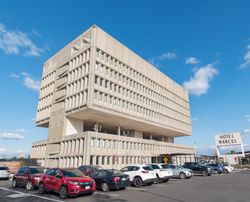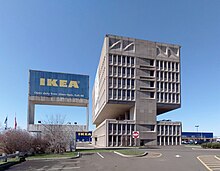Brutalist architecture is an architectural style that emerged during the 1950s in the United Kingdom, among the reconstruction projects of the post-war era. Brutalist buildings are characterised by minimalist constructions that showcase the bare building materials and structural elements over decorative design. The style commonly makes use of exposed, unpainted concrete or brick, angular geometric shapes and a predominantly monochrome colour palette; other materials, such as steel, timber, and glass, are also featured.

New Haven Coliseum was a sports and entertainment arena located in downtown New Haven, Connecticut. Construction began in 1968 and was completed in 1972. The Coliseum was officially closed on September 1, 2002, by Mayor John DeStefano Jr., and demolished by implosion on January 20, 2007.
Long Wharf is a waterfront district and neighborhood of the city of New Haven, Connecticut, United States. The neighborhood is a mixed-use district, with a combination of commercial, industrial, port, and recreation facilities.
The year 1970 in architecture involved some significant architectural events and new buildings.

Marcel Lajos Breuer, was a Hungarian American modernist architect and furniture designer. He moved to the United States in 1937 and became a naturalized American citizen in 1944.

Alice Tully Hall is a concert hall at the Lincoln Center for the Performing Arts in the Upper West Side neighborhood of Manhattan in New York City. The hall is named for Alice Tully, a New York performer and philanthropist whose donations assisted in the construction of the hall. Tully Hall is located within the Juilliard Building, a Brutalist structure, which was designed by architect Pietro Belluschi. It was completed and subsequently opened in 1969. Since its opening, it has hosted numerous performances and events, including the New York Film Festival. Tully Hall seats 1,086 patrons. It is the home of the Chamber Music Society of Lincoln Center.

Rudolph Hall is one of the earliest and best-known examples of Brutalist architecture in the United States. Completed in 1963 in New Haven, Connecticut, the building houses Yale University's School of Architecture. Until 2000, it also housed the School of Art.

The Henry F. Miller house is an international style house at 30 Derby Avenue in Orange, Connecticut on the United States National Register of Historic Places. The house was designed and built in 1948-1949 by Henry F. Miller as a thesis project for a Master of Architecture at the Yale School of Architecture. The house was one of the areas first modern houses and was featured in the New Haven Register as "The House of Tomorrow". It was open to visitors for a few weeks after completion to raise funds for the New Haven Boy's Club. It was viewed with "wild anticipation," and about 25,000 people paid a small admission to see it. The house was also covered in House Beautiful as part of a series on "The New American Style."
John MacLane Johansen was an American architect and a member of the Harvard Five. Johansen took an active role in the modern movement.

The Boston Government Service Center (BGSC) is a state government complex in the West End of Boston, Massachusetts. The center was designed in the Brutalist style, led by architect Paul Rudolph. It is one of the major components of the Government Center complex in Downtown Boston. The complex is made up of two connected Brutalist buildings: the Charles F. Hurley Building and the Erich Lindemann Building, as well as a courtyard; sometimes included is the newer, 1998-built, Edward W. Brooke Courthouse.

The Robert C. Weaver Federal Building is a 10-story office building in Washington, D.C., owned by the federal government of the United States. Completed in 1968, it serves as the headquarters of the United States Department of Housing and Urban Development (HUD). Built by the General Services Administration, it is a prime example of Brutalist architecture. The structure is named for Dr. Robert C. Weaver, the first Secretary of Housing and Urban Development and the first African American Cabinet member.
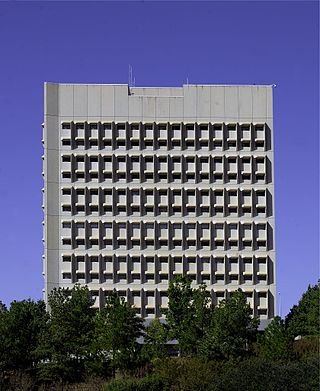
The Strom Thurmond Federal Building and United States Courthouse is United States federal building located in Columbia, South Carolina, which was completed in 1979 and which served for twenty-five years as a courthouse of the United States District Court for the District of South Carolina. It is named for long-time Senator Strom Thurmond, and is listed on the National Register of Historic Places.
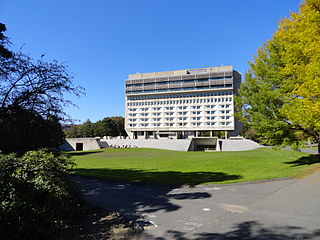
Murray D. Lincoln Campus Center is a high-rise building on the University of Massachusetts Amherst campus, in Amherst, Massachusetts.

The Hubert H. Humphrey Building is a low-rise Brutalist office building located in Washington, D.C., in the United States. Originally known as the South Portal Building, the Hubert H. Humphrey Building was dedicated on November 1, 1977. It became the headquarters of the United States Department of Health, Education, and Welfare (HEW). After the department's education component was given to the newly created United States Department of Education in 1979, the newly named United States Department of Health and Human Services (HHS) continued to occupy the structure.

The Swetland Building, also known as 1010 Euclid Avenue, is a 175 foot (53 m), 13-story historic high-rise building in the Nine-Twelve District of downtown Cleveland built in 1910. It is located at the intersection of Euclid and East 9th Street near other historic buildings such as the Cleveland Athletic Club, Huntington Bank Building, and Statler Arms Apartments. The Swetland is of the Chicago school of architecture and has many intricate details at its base and summit, typical of the Chicago style. Architect Alexander C. Wolf of East Cleveland had his offices in the structure and later served as a member of the Cleveland Planning Commission. Also present in the building was fine jeweler Rickey C. Tanno who started his company in 1929 in the Swetland and remained there until 1949, when he moved across the street into the Union Commerce Bank Building.
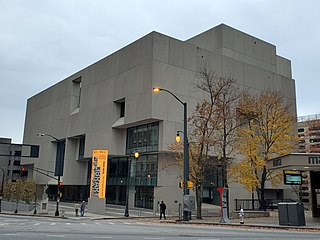
The Atlanta Central Library in Downtown Atlanta is the main library and headquarters of the Atlanta–Fulton Public Library System. The library, built from 1977 to 1980, has a Brutalist design by architect Marcel Breuer – his last work, and his only work in Atlanta. The building was partially renovated in 2002, and a complete renovation took place from 2018 to 2021, following a 2016 vote against demolishing the structure.
Torin Building is a heritage-listed former factory and now factory and office space located at 26 Coombes Drive in the western Sydney suburb of Penrith in the City of Penrith local government area of New South Wales, Australia. It was designed by Marcel Breuer and built from 1975 to 1976. It is also known as the Former Torin Corporation Building and Breuer Building. It was added to the New South Wales State Heritage Register on 15 May 2009.

St. Francis de Sales Catholic Church is a parish of the Roman Catholic Church in Norton Shores, Michigan, USA. With a membership of about 1,300 households, it is the largest parish in the surrounding Muskegon area. The parish's current building, noted for its hyperbolic paraboloid form and brutalist design, was designed by modernist architect Marcel Breuer and his associate Herbert Beckhard in 1964.

945 Madison Avenue, also known as the Breuer Building, is a museum building in the Upper East Side of Manhattan, New York City. The Marcel Breuer-designed structure was built from 1964 to 1966 as the third home for the Whitney Museum of American Art. The Whitney moved out in 2014, after nearly 50 years in the building. In 2016, it was leased to the Metropolitan Museum of Art and became the Met Breuer, which closed in 2020. The building currently houses the Frick Madison, the temporary home of the Frick Collection set for a two-year period that began in March 2021. There are no public plans for the building after the Met's lease expires in 2023.
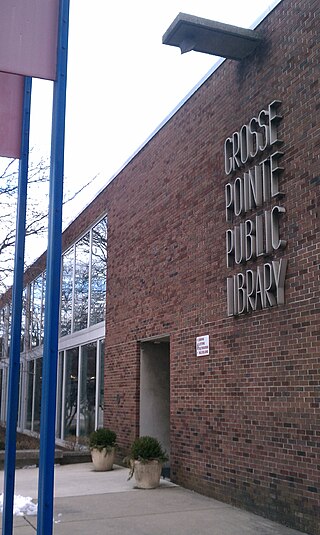
The Grosse Pointe Public Library Central Branch, located at 10 Kercheval Avenue in Grosse Pointe Farms, Michigan, is one of the buildings of the Grosse Pointe Public Library. Constructed in 1953, it is significant as one of the first major public commissions in the United States of architect Marcel Breuer. The building was listed in the National Register of Historic Places in 2021.

